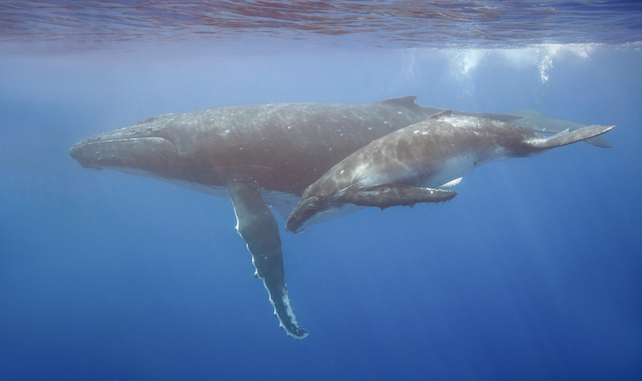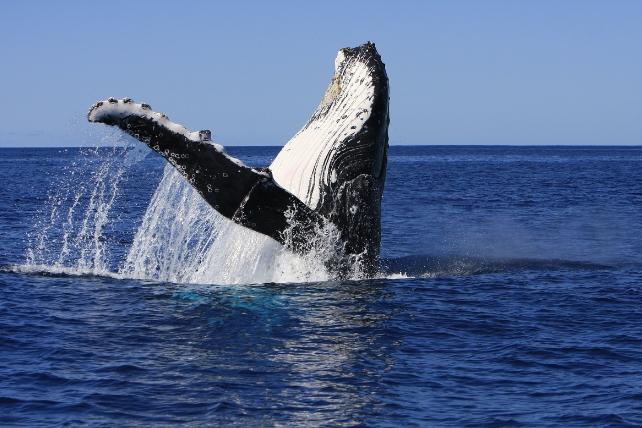Two new studies have found eerily human-like sophistication in whale songs, challenging notions about our exceptionality and potentially shedding light on the evolution of language.
Some whales can match or even surpass the efficiency of our speech, one of the studies found, with humpback whales (Megaptera novaeangliae) providing the closest competition.
In the second study, researchers report that humpback songs adhere to a statistical structure considered a hallmark of human language.
"These findings challenge long-held assumptions about the uniqueness of human language, uncovering deep commonalities between evolutionarily distant species," says Simon Kirby, professor of language evolution at the University of Edinburgh.
Aside from impressing and humbling us, the whales' abilities could help us better understand the language of other animals and our own. A growing body of research suggests lots of species have intricate communication systems, and many exhibit qualities once deemed uniquely human.
In the efficiency paper, ethologist and computational scientist Mason Youngblood from Stony Brook University used a pair of linguistic laws to examine the efficiency of 51 human languages and 65,511 whale-song sequences.
Natural selection favors efficient communication, Youngblood notes, which helps individuals share vital information quickly and simply.
Complex signals can convey more, he acknowledges, and redundancy helps ensure accurate transmission, but those benefits aren't free. Prattling takes valuable time and energy, and could attract predators.
To quantify the efficiency of human and whale communication, Youngblood used two linguistic principles: Menzerath's law and Zipf's law of abbreviation.
According to Menzerath's law, efficiency increases when longer sequences like words, sentences, or songs consist of shorter elements, like words, phonemes, or notes, Youngblood explains.
Per Zipf's law of abbreviation, a communication system is more efficient if frequently used elements – like words, phonemes, and notes – are shorter.
Youngblood applied both laws to vocalization sequences from 16 cetacean species, including baleen whales as well as dolphins and other toothed whales. For comparison, he also assessed 51 human languages.
Calls from 11 of 16 species exhibited Menzerath's law as much or more than human speech.
The exceptions were orcas (Orcinus orca), Hector's dolphins (Cephalorhynchus hectori), Commerson's dolphins (Cephalorhynchus commersonii), Heaviside's dolphins (Cephalorhynchus heavisidii), and North Pacific right whales (Eubalaena japonica).
Most species didn't display Zipf's law of abbreviation, Youngblood reports. It appeared just in humpback and blue whales (Balaenoptera musculus), with only humpbacks rivaling humanity's embrace of the law.

For the second study, researchers focused on humpback whale songs, applying quantitative methods traditionally used to evaluate speech in human babies.
Previous research has identified a specific attribute of human language that seems to aid learning and promote language preservation. Structurally coherent units of a language display a frequency distribution governed by a power law called a Zipfian distribution.
This seems to help babies learn a language more easily, the researchers on the new study note, and "likely enhances the accurate preservation of language across generations."
Humpback songs are similarly complex, often arising from nested hierarchical components. For example the whales create phrases using individual sound elements, then repeat phrases to form themes, and put themes together to build songs.
Humpbacks also pass on songs culturally, as we do with language. If the statistical properties of human languages evolved for smoother cultural transmission, the authors say, then similar signs should appear in whale songs.
To test that idea, they analyzed eight years of humpback recordings with speech-segmentation techniques designed for use with human infants.
Humpback whale songs have the same statistical structure as human language, offering a glimpse into the origins of complex communication.
— News from Science (@NewsfromScience) February 13, 2025
Learn more: https://t.co/kXkRUS5Fnq pic.twitter.com/hWfADXo0Jn
This revealed hidden structure in the songs, including statistically coherent subsequences whose frequency followed a Zipfian distribution – traits found in all human languages.
The subsequence lengths also adhere to Zipf's law of brevity, the researchers add, which states more frequently used linguistic units tend to be shorter.
"Using insights and methods from how babies learn language allowed us to discover previously undetected structure in whale song," says first author Inbal Arnon, a developmental psycholinguist at Hebrew University of Jerusalem.

Finding this hidden, "language-like" structure was a surprise, adds behavioral ecologist Ellen Garland from the University of St. Andrews. Whale songs lack the semantic meaning of language, she explains, and may be more comparable to human music.
Nonetheless, Garland says this discovery "strongly suggests this cultural behavior holds crucial insight into the evolution of complex communication across the animal kingdom."
The studies were published in Science Advances and Science.
